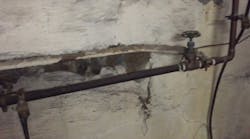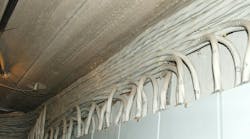Mix and Match
These energized multiconductor cable assemblies supplied kitchen equipment in a mess hall. As you can clearly see, they were not protected from physical damage, nor was the raceway completely installed. This is a clear violation of 300.18 [Raceway Installations].
As noted in the first sentence of 300.18(A), “Raceways, other than busways or exposed raceways having hinged or removable covers, shall be installed complete between outlet, junction, or splicing points prior to the installation of conductors.” An Exception in this section of the Code states, “Short sections of raceways used to contain conductors or cable assemblies for protection from physical damage shall not be required to be installed complete between outlet, junction, or splicing points.” However, the exception does not apply here.
The mechanical continuity of the raceway can also be cited here. As per 300.12 [Mechanical Continuity – Raceways and Cables], “Metal or nonmetallic raceways, cable armors, and cable sheaths shall be continuous between cabinets, boxes, fittings, or other enclosures or outlets.” Again, the first of two Exceptions in this section states, “Short sections of raceways used to provide support or protection of cable assemblies from physical damage shall not be required to be mechanically continuous.” But once again, the exceptions do not apply to this installation.
Splice in a Bottle
Electrical improvisation rears its ugly head once again. This dirty mess was unearthed near a sump pump that had stopped working. Some fool thought this plastic bottle would make a nifty home for a splice point. What’s worse is these types of cords and cables are not designed to be installed on or under the ground. As noted in the first sentence of 110.8 [Wiring Methods], “Only wiring methods recognized as suitable are included in this Code.”
Is a splice box required at this location? Well, it depends. As per 300.15(G) [Direct-Buried Conductors], “As permitted in 300.5(E), a box or conduit body shall not be required for splices and taps in direct-buried conductors and cables.” But this assumes you’re using properly listed components. Section 314.29 [Boxes, Conduit Bodies, and Handhole Enclosures to Be Accessible] states, “Boxes, conduit bodies, and handhole enclosures shall be installed so that the wiring contained in them can be rendered accessible without removing any part of the building or, in underground circuits, without excavating sidewalks, paving, earth, or other substance that is to be used to establish the finished grade.” An Exception in this section notes, “Listed boxes and handhole enclosures shall be permitted where covered by gravel, light aggregate, or noncohesive granulated soil if their location is effectively identified and accessible for excavation.”





